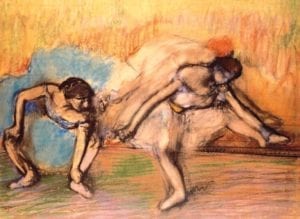How Do You Feel When A Painter Or Sculptor Changes Their Style?

Edgar Degas, Two Dancers Resting, 1896, Pastel, 31” x 41”
This article was published in the December 2015 issue of Nashville Arts Magazine
by Rachael McCampbell
Picasso is probably the first artist who comes to mind when I think of style changers. He was more interested in the artistic process at hand than trying to keep in alignment with his “brand.” Picasso didn’t paint to please his public or his dealers. He said, “When we did Cubist paintings, our intention was not to produce Cubist paintings but to express what was within us. No one laid down a course of action for us . . .” Picasso’s stylistic phases went from figurative, which included the Blue and Rose Periods, to Analytic and Synthetic Cubism to Collage to Neoclassicism, Surrealism, and Expressionism. Picasso boldly experimented with child-like zeal most of his life, and it worked.
There are other artists who are content to come across a style or method and happily explore that one idea their whole working life. Josef Albers, for example, spent 30 years experimenting with the juxtaposition of flat, hard-edged colors generally formatted within square and rectangular shapes. Albers, having been a part of the European Constructivist and Bauhaus movements, strongly influenced the American Op and Conceptualist artists who were interested in his ideas of visual perception and color. A positive outcome of this is that Albers’ work is easily identifiable—one glance and you know it’s an Albers.
Some artists change their styles because they don’t have a choice. Degas, Monet, and Matisse come to mind. Degas’ retinal disease and Monet’s cataracts caused them both to perceive blurry figures, landscapes, and still lifes, which added to the softness of their already Impressionistic style. Matisse, on the other hand, had abdominal cancer, and, after undergoing surgery at 72, was forced to remain chair or bedridden. He gave up painting and sculpting to explore a new style he called “cut-outs” or “decoupage.” With the help of assistants, he created abstracted color studies with torn paper glued to canvases. What might be conceived as physical handicaps pushed their styles to new and unexpected levels of greatness.
Art schools stress the importance of a unified presentation when trying to get into a gallery. If Picasso were to show up today at a meeting with samplings of his best masterpieces over seven decades, he would probably get rejected for not possessing a consistent style and focus. Galleries want to show one style at a time, which makes sense, but I think it’s unrealistic to expect an artist to stay the same forever. After all, we are our art and our art is us. Since people change and grow, it’s predictable that their art will change too. Yet, sadly, some artists find a successful, recognizable style and won’t experiment out of those bounds for fear that their collectors will reject them and their dealers will drop them.
Artists are usually artists because they don’t want to live in boxes where repetitive schedules and stagnant routines can suck them dry. The rest of the world depends on them to be risk takers and try things that they’re too scared to try themselves. I believe that experimentation in art is key to growth and happiness. Collectors and dealers need to understand that it’s okay for artists to venture out and play—actually it’s essential. Artists, change up your style if it makes your heart sing. And remember, fear has no place in the artist’s studio or life—but if you get stuck, just think, “What would Picasso do?”
This article was published in the December issue of Nashville Arts Magazine. Please go to stands or online to see the published version.
Rachael McCampbell is an artist, teacher, curator, and writer who resides in the small hamlet of Leiper’s Fork, Tennessee. For more about her, please visit www.rachaelmccampbell.com.



Bonjour, ton blog est très réussi ! Je te dis bravo ! C’est du beau boulot !:)
Hello and thank you for this blog is a true inspiration..